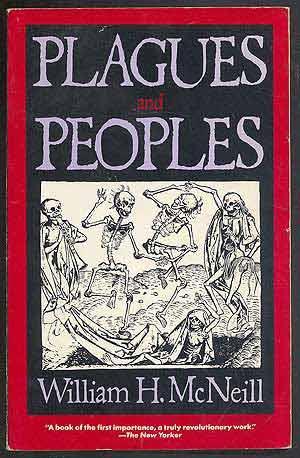The Hot Zone: A Terrifying True Story, Richard Preston, Random House, 1994, pp. 300, ISBN 0-679-43094-6
In Wolfgang Petersen’s 1995 movie Outbreak, a deadly virus escapes its rainforest home in Africa when Patrick Dempsey poaches a capuchin and trades him in the United States as a pet. The monkey sneezes directly into Dempsey’s mouth, infecting him with a mysterious Motaba virus that was thought to have been eradicated decades earlier. Later, the monkey scratches a pet shop owner, while Dempsey goes on to infect his girlfriend and next thing you know, outbreak.
While the plotline is heavily fictionalized and changed, the inspiration came from a true story told by Richard Preston about a contained outbreak of a strain of the Ebola virus in a small Virginia town called Reston. The plots diverge drastically, but the common ground is the fact that viruses jump to humans when the ecological balance is disturbed, potentially leading to a spread with terrifying consequences. Had Petersen decided to follow Preston’s account to the letter, the movie would have been just as frightening, and the book’s graphic portrayal of events lends itself for the adaptation to the big screen.
While Preston focuses heavily on the contained outbreak at the Hazleton Research Products facility in Reston in 1989 and 1990, he does provide a shorter account of the previous outbreaks of viruses of a similar strain of the thread-shaped filoviruses. There are currently two known genera of them, the Marburgvirus and Ebolavirus, and are mainly found in different species of fruit bats and monkeys. Both viruses replicate inside cells to such high titers that they cause the cell to enlarge and burst. Preston describes the agony of one known victim of Marburg virus thus:
“he loses consciousness and pitches forward onto the floor. The only sound is a choking in his throat as he continues to vomit while unconscious. Then comes a sound like a bedsheet being torn in half, which is the sound of his bowels opening and venting blood from the anus. The blood is mixed with intestinal lining. He has sloughed his gut.”
Marburg was discovered in a vaccine factory in West Germany in 1967 when 31 lab workers fell ill. The virus was traced to a species of an African fruit bat, but the route of transmission remains unknown to this day. The virus spreads through bodily fluids alright, but whether it can be spread through aerosols is yet to be determined. After an incubation period of up to 21 days, the host develops a fever, splintering headache and myalgia, followed by hemorrhage. The most recent outbreak occurred in 2005 in Angola’s Ulige province, which saw 329 deaths. Every now and then, tourists to the region get infected and die.
Ebola, on the other hand, has five different species. The first one was discovered in Sudan in 1976, from where it spread to Zaire, killing between 50 and 90 percent of its victims in its wake. The then-dictator of Zaire, Mobutu Sese Seko, ordered entire villages and hospitals sealed off with instructions to shoot to kill anyone trying to escape the zone. While Preston offers no account of local attempts to contain the virus beyond this seemingly brutal manner of dealing with it, he does introduce us to the doctors from the US Centre for Disease Control, who parachuted into Zaire to “try to organize the effort to stop the virus.” Granted, Karl Johnson was one of the scientists who had managed to isolate the virus successfully, and Joel Breman did manage to enter the hot zone that was the isolated village of Bumba. Still, the intense thriller-like focus on the doctors ignores the underlying reasons that led to the virus jumping to humans in the first place and the reasons why the local health-care system was unable to deal with the outbreak. Could it be the dictatorial regime propped up from the outside in the wake of neoliberal restructuring of Africa and the debt crisis? Perhaps. What the “Ebola River” chapter does though is tell the story of brave Western men and a South African woman.
Preston’s account of periodic outbreaks of filoviruses takes us into the inner workings of the United States Army Medical Research Institute of Infectious Diseases (USAMRIID) at Fort Detrick by way of introducing its chief scientists, procedures the personnel follows and their work. By way of Nancy and Jerry Jaax, veterinarians at the institute, we learn about the meaning of the hot zone, an area within which highly lethal pathogens are handled. We learn about the different biosafety levels and what preparations and gear are needed to enter them, as well as the potential consequences of the scientist’s mishaps. In short, lots of layers of protective coating, rubber gloves and disinfectant.
Preston’s attention to trivial details and a rather deep exploration of the characters’ personal lives and relationships would have added to a fictionalized account, but in a non-fiction one takes away from the main plotline. He goes to great length to tell a story in a good way, rather than a good story. Important aspects that deserve more commentary are glossed over for the fluidity of the narrative.
About the crab-eating monkeys that were imported in the US from a “monkey wholesale facility” in the Philippines, we are told that they “themselves come from coastal rain forests on the island of Mindanao.” The monkeys are “grouped in large cages known as gang cages” then “put into wooden crates” and are especially useful as “laboratory animals because they are common, cheap and easily obtained.” When at Reston monkey house, they were “placed each in its own cage, under artificial lights, and were fed monkey biscuits and fruit.” We are also told that they are pests. What the narrative fails to observe is that the conflict over resources arose with drastic urbanization and deforestation, which led to habitat loss, as well as the brutality by which the monkeys are captured, sold, warehoused and commodified. This point goes beyond the notion of mere environmental protection but is crucial to the narrative of virus outbreaks. It is the very reason why viruses can jump to humans and spread. By omitting this, Preston allows himself to describe the viruses as “compact, hard, totally selfish,” with a “motive without a mind.” While he does acknowledge that AIDS is “the revenge of the rainforest,” Marburg and Ebola are accorded the status of viruses “trying to crash into the human species,” rather than the other way around.
Preston chooses to focus on the developments at the Hazleton Research Products facility when the monkeys started to die and did so with a dramatic flair. With a lot of intensity, he describes how the army and the CDC dealt with the need to euthanize hundreds of animals and contain the possible outbreak. In so doing, the reader realizes that it is difficult, even for the presumably most prepared institution in the world, to deal with the spread of infectious diseases. It is all very new and terrifying.
If unwillingly, ultimately, Preston’s is a graphic portrayal of the potential viruses have to cause havoc in humans. Experts will find it difficult to prevent its spread if the system making this likely is not changed.




